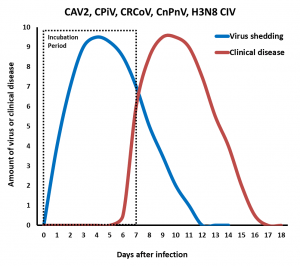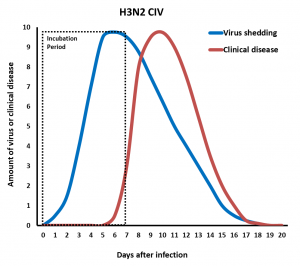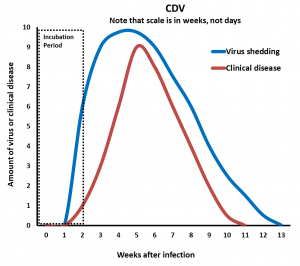Module 4: Healthcare practices for common contagious infectious diseases
Canine Respiratory Pathogens and Their Properties
VIRUSES
- Parainfluenza virus (CPiV)
- Adenovirus type 2 (CAV2)
- Distemper virus (CDV)
- H3N8 canine influenza virus (H3N8 CIV)
- H3N2 canine influenza virus (H3N2 CIV)
- Respiratory coronavirus (CRCoV)
- Pneumovirus (CnPnV)
- Canine herpes virus (CHV)
BACTERIA
- Bordetella bronchiseptica (Bordetella)
- Streptococcus zooepidemicus (Strep zoo)
- Mycoplasma cynos (M. cynos)
Incubation Period
The incubation period for the known bacterial and viral respiratory pathogens is 7 days or less. This short incubation period contributes to a rapid increase in number of dogs with kennel cough within a short period of time. The exception is CDV. The CDV incubation period is typically 2 weeks and this longer period causes delays in recognizing affected dogs and contributes to a slow insidious increase in number of dogs with kennel cough and progressive disease. Preclinical shedding occurs for all of the respiratory pathogens, meaning infected dogs are contagious before appearance of clinical signs.
Shedding Period
Most of the viral pathogens are shed in respiratory secretions for <14 days. The short shedding period contributes to feasibility of isolating affected dogs for 2 weeks before safely releasing back into the shelter population or to adoption groups or new owners. The exceptions are CDV, H3N2 CIV, Bordetella, Mycoplasma, and Strep zoo.
Here is a summary table of the CIRD pathogen properties. The incubation and shedding periods are included in the Canine Respiratory Infections in Shelters document.
Summary of Canine Viral CIRD Properties
| CAV2 | CPiV | CDV | H3N8 CIV | H3N2 CIV | CRCoV | CnPnV | CHV | |
|---|---|---|---|---|---|---|---|---|
| Pathogen type | DNA virus | RNA virus | RNA virus | RNA virus | RNA virus | RNA virus | RNA virus | DNA virus |
| Transmission route | direct contact, droplets, aerosols, fomites | direct contact, droplets, aerosols, fomites | direct contact, droplets, aerosols, fomites, feces, urine | direct contact, droplets, aerosols, fomites | direct contact, droplets, aerosols, fomites | direct contact, droplets, aerosols, fomites | direct contact, droplets, aerosols, fomites | direct contact, droplets, aerosols, fomites |
| Incubation period | ≤1 wk | ≤1 wk | 2 wks | ≤1 wk | ≤1 wk | ≤1 wk | ≤1 wk | ≤1 wk |
| Shedding period | <2 wk | <2 wk | wks-mos | <2 wk | ≤3 wks | <2 wk | <2 wk | <2 wk |
| Persistent infection | no | no | no | no | no | no | no | yes |
Summary of Canine Bacterial CIRD Properties
| Bordetella | M. cynos | Strep zoo | |
|---|---|---|---|
| Pathogen type | gram-negative bacteria | bacteria w/o cell walls | gram-positive bacteria |
| Transmission route | direct contact, droplets, aerosols, fomites | direct contact, droplets, aerosols, fomites | direct contact, droplets, aerosols, fomites |
| Incubation period | ≤1 wk | ≤1 wk | ≤1 wk |
| Shedding period (w/o antibiotics) |
≤3 mo | weeks | weeks |
| Persistent infection | no | unknown (w/o antibiotics) | unknown (w/o antibiotics) |
Duration of Virus Shedding and Clinical Disease for CIRD Viruses
Note: Click each graph to access the full-size version.
Most of the viral and bacterial respiratory pathogens cause subclinical infections in a proportion of exposed dogs. Subclinically infected dogs shed the pathogen in oronasal secretions, but the amount of shed pathogen is typically much smaller and for shorter periods of time. However, the inability to identify subclinically infected dogs ensures that more dogs are exposed by direct contact.
Transmission
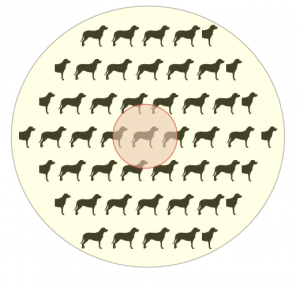
The viral and bacterial respiratory pathogens are spread by contact with oronasal secretions from infected dogs. Sneezing and coughing generates large pathogen-containing droplets that spread within a 5-foot zone around the dog. Coughing also generates aerosols or fine mists that can spread within a 20-foot zone around the dog. The large droplets and aerosols are a major source of respiratory pathogen spread in a kennel. This is why clinically ill dogs should be promptly isolated from the population to decrease spread of infectious doses in the environment and to other dogs.
The typical shelter kennel layout contains rows of runs that are separated by concrete half-walls topped by chain link fencing. The doors are chain link. There may be two rows of runs facing each other separated by a 6-to 8-foot walkway. Droplets and aerosols generated by sneezing and coughing dogs can easily spread to other dogs in this setting.
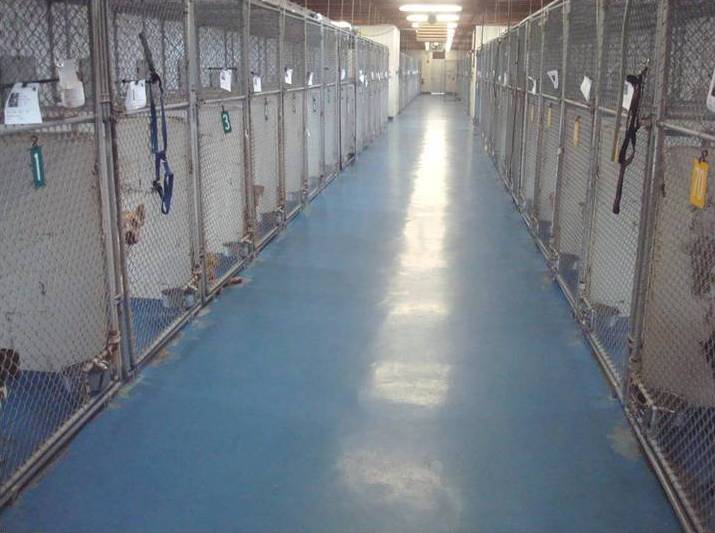
Watch This
Here is a 3D model that illustrates how human coughing can generate aerosols that travel 10 feet or more over several minutes. Note that the setup in this model is similar to dog runs in a shelter. (0:50 | no sound)

